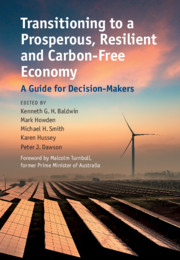Book contents
- Transitioning to a Prosperous, Resilient and Carbon-Free Economy
- Transitioning to a Prosperous, Resilient and Carbon-Free Economy
- Copyright page
- Dedication
- Contents
- Figures
- Tables
- Contributors
- Foreword
- Introduction
- 1 Policy Frameworks and Institutions for Decarbonisation: The Energy Sector as ‘Litmus Test’
- Technologies for Decarbonising the Electricity Sector
- Example Economies
- Cities and Industry
- Land Use, Forests and Agriculture
- 17 Land Use
- 18 Forests
- 19 Agriculture
- Mining, Metals, Oil and Gas
- Addressing Barriers io Change
- Index
- References
17 - Land Use
from Land Use, Forests and Agriculture
Published online by Cambridge University Press: 08 October 2021
- Transitioning to a Prosperous, Resilient and Carbon-Free Economy
- Transitioning to a Prosperous, Resilient and Carbon-Free Economy
- Copyright page
- Dedication
- Contents
- Figures
- Tables
- Contributors
- Foreword
- Introduction
- 1 Policy Frameworks and Institutions for Decarbonisation: The Energy Sector as ‘Litmus Test’
- Technologies for Decarbonising the Electricity Sector
- Example Economies
- Cities and Industry
- Land Use, Forests and Agriculture
- 17 Land Use
- 18 Forests
- 19 Agriculture
- Mining, Metals, Oil and Gas
- Addressing Barriers io Change
- Index
- References
Summary
Human activities in the land sector produce the second highest level of greenhouse gas emissions globally and the highest in some countries, but the land is also a major sink for anthropogenic emissions. This land carbon sink is at risk because plant growth, survival and distributions are dependent on climate conditions and particularly extreme events: higher temperatures, reduction in water availability in some areas and flooding in others, droughts and wildfires. Agricultural and forest productivity are affected by the combined pressures of climate change, demand for land resources for food production, deforestation and degradation of natural systems, and population pressure. The land sector provides numerous opportunities for mitigation, many of which are cost-effective and can be implemented quickly. However, the land sink has limits because the uptake of carbon represents replacing the stock that was previously depleted by human activities, and productivity is limited by nutrient and water availability. Potential mitigation activities should be assessed in terms of the magnitude, timeframe and cost of the changes in carbon stocks.
Keywords
- Type
- Chapter
- Information
- Transitioning to a Prosperous, Resilient and Carbon-Free EconomyA Guide for Decision-Makers, pp. 441 - 461Publisher: Cambridge University PressPrint publication year: 2021



